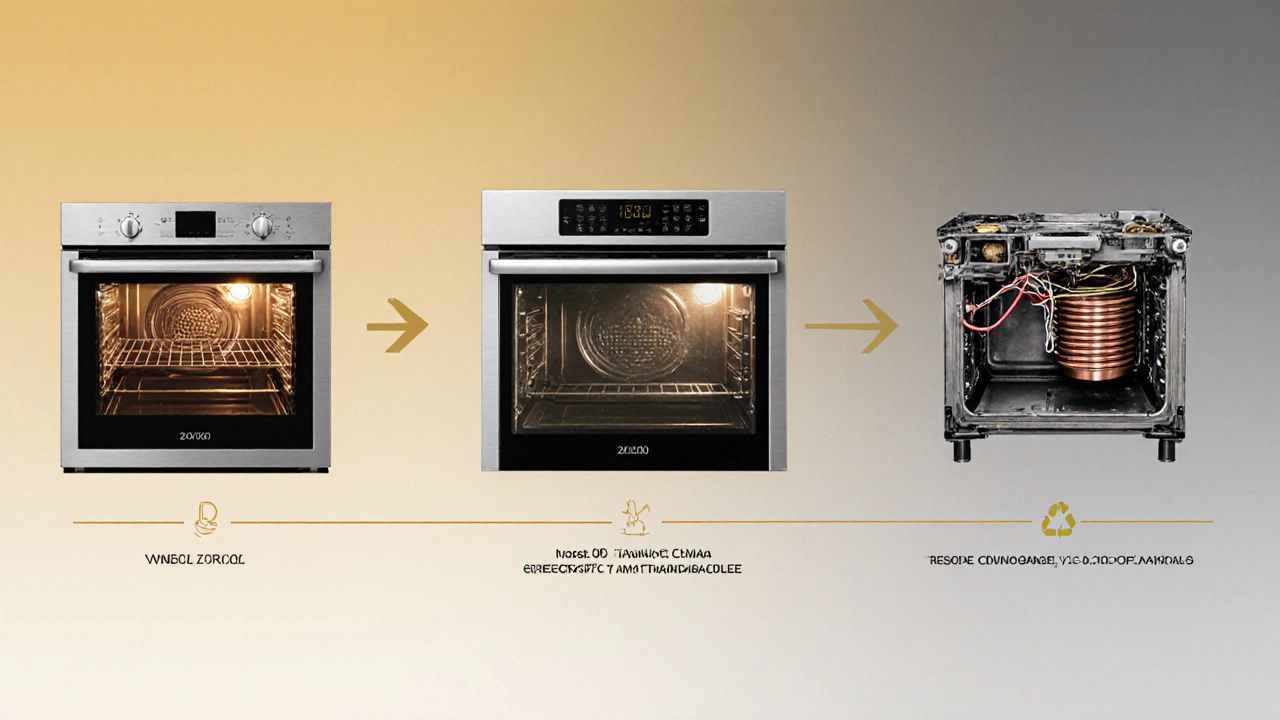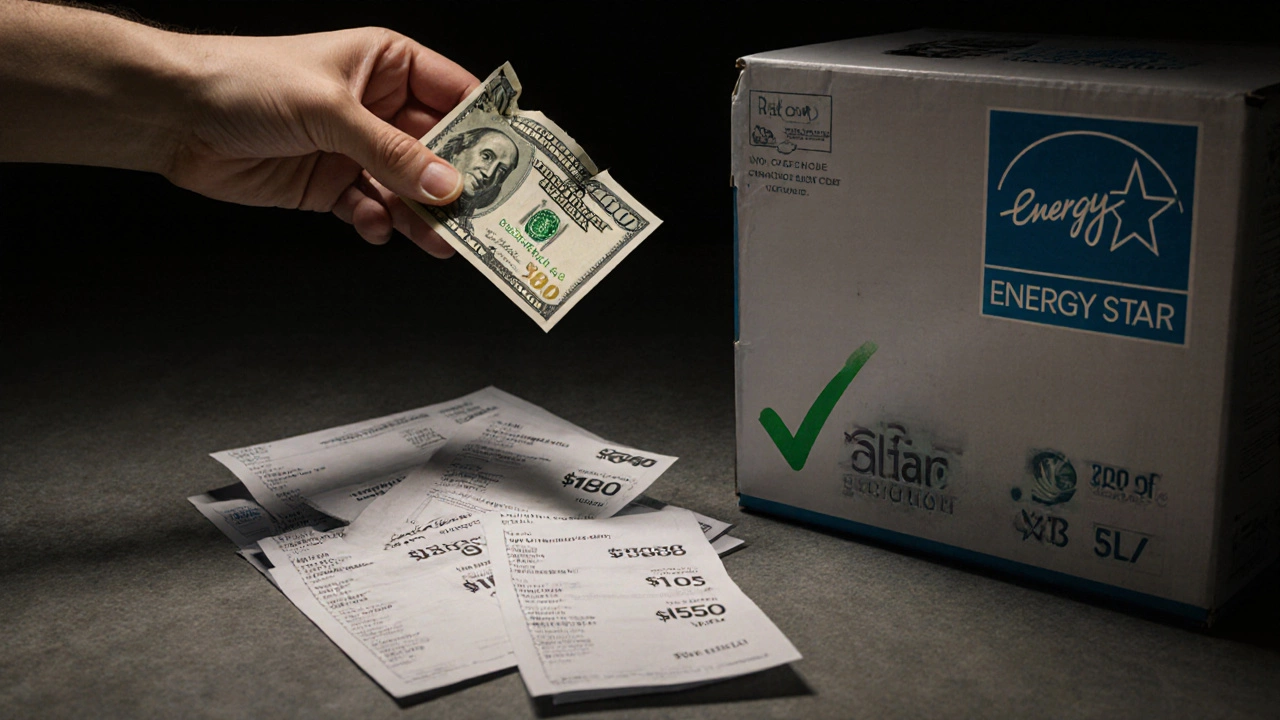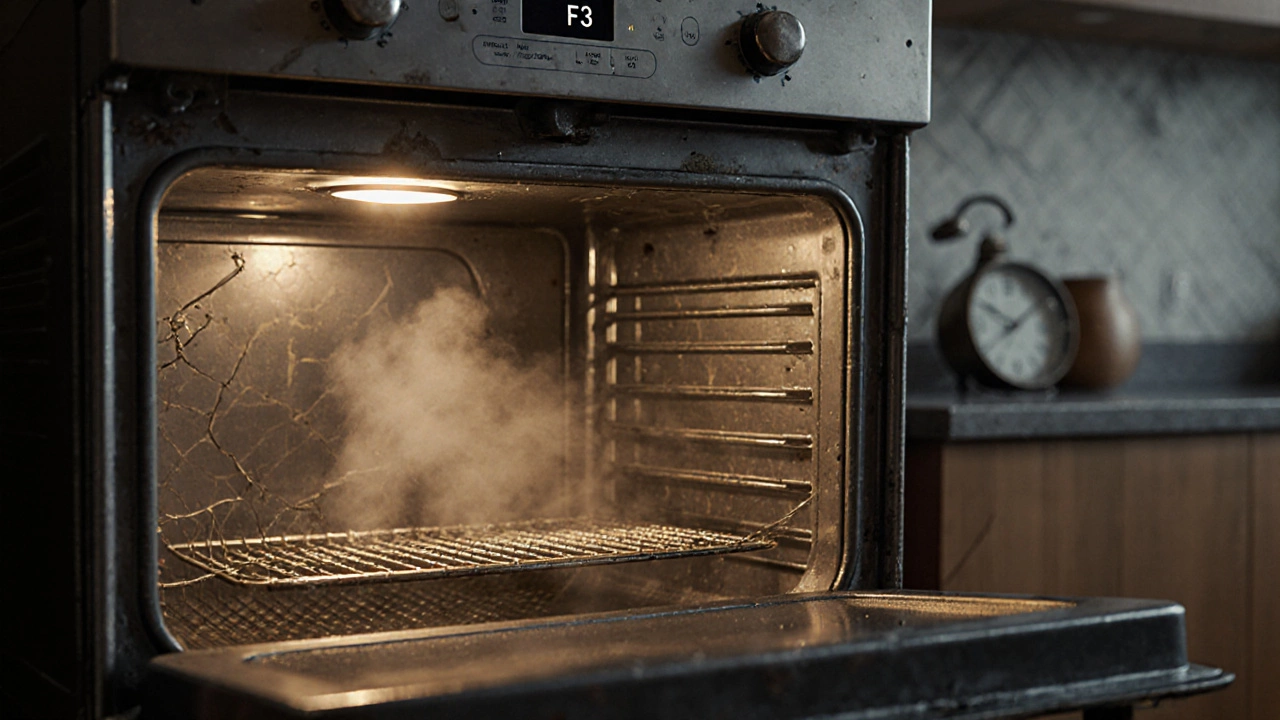Oven Replacement Calculator
Most people don’t think about their oven until it stops working. But if you’ve had yours for more than a decade, you’re probably wondering: is it time to replace it, or can it still be fixed? The truth is, ovens don’t have a fixed expiration date - but they do have a typical lifespan, and knowing what to expect can save you money and hassle.
How Long Do Ovens Usually Last?
On average, a standard electric or gas oven lasts between 13 and 15 years. That’s the number you’ll see from manufacturers and appliance repair professionals alike. But this isn’t a hard rule. Some ovens die at 8 years. Others keep working past 20. What makes the difference? Usage, maintenance, and build quality.
High-end models from brands like Wolf, Sub-Zero, or Viking often last longer - sometimes 20+ years - because they use thicker steel, better insulation, and more durable heating elements. Budget ovens, especially those bundled with new kitchens, tend to wear out faster. They’re built to meet a price point, not a lifetime.
What Wears Out First?
Ovens don’t just suddenly quit. Something breaks first, and that’s your warning sign. Here’s what usually fails, in order:
- Heating elements - The most common failure. The bake and broil elements crack, burn out, or stop glowing. Easy fix, often under $50.
- Thermostat or temperature sensor - If your oven runs too hot or too cold, this is likely the culprit. Replacing it costs $60-$120, depending on the model.
- Igniter (gas ovens) - If the gas won’t light, the igniter is probably worn out. These last about 8-10 years before failing.
- Control board - Digital displays that flicker, buttons that don’t respond, or error codes like F1 or F3 usually mean the control board is dying. Repair costs $150-$300.
- Door seal - A cracked or warped gasket lets heat escape. This reduces efficiency and makes the oven work harder, shortening its life.
If you’ve replaced two or more of these parts in the last 3 years, your oven is in its final phase. At that point, repairs add up fast - and you’re just delaying the inevitable.
Signs Your Oven Is Past Its Prime
You don’t need a technician to tell you it’s time. Here are the red flags that mean your oven is running on borrowed time:
- It takes longer than 20 minutes to preheat - even after cleaning the elements.
- Food cooks unevenly - one side burns, the other’s raw. This often means the heating elements are failing or the fan (in convection models) is worn out.
- You smell gas when it’s off (gas ovens only) - a sign of a leaking valve or cracked line. This isn’t just a repair issue - it’s a safety hazard.
- Energy bills have crept up without changes in usage - old ovens lose insulation and efficiency over time.
- The control panel is glitchy - flickering numbers, unresponsive buttons, or random error codes. This means the electronics are failing.
One homeowner in Ohio replaced her oven’s heating element three times in five years. Each repair cost $80-$110. By year 14, she spent $500 on fixes and finally bought a new oven for $700. She saved money by waiting - but only because she knew when to stop throwing cash at it.

Does Repairing an Old Oven Make Sense?
There’s a simple rule: if the repair costs more than half the price of a new oven, walk away.
Let’s say your oven is 12 years old. A new mid-range model costs $600. If a repair will cost $350 or more, it’s not worth it. Even if the oven still works, you’re paying for aging parts that will fail again soon.
There are exceptions:
- You have a high-end oven that’s still under warranty or has rare features you can’t replace.
- The issue is a simple, cheap fix - like a $30 thermostat or a $25 door seal.
- You’re on a tight budget and can’t afford a new one right now - but you plan to replace it within a year.
Otherwise, repairing an oven older than 10 years is like putting new tires on a 20-year-old car. You’re buying time, not value.
How to Make Your Oven Last Longer
Even the best oven won’t last if you ignore it. Here’s what actually helps:
- Clean spills right away - Burnt-on food puts stress on the heating elements and insulation. Wipe spills with a damp cloth after the oven cools.
- Avoid self-clean mode - It heats the oven to 900°F+, which wears out wiring, seals, and sensors faster. Use the manual clean method instead.
- Check the door seal yearly - Run a dollar bill around the door. If it pulls out easily, the seal is worn. Replace it for under $40.
- Don’t overload the racks - Too much weight strains the supports and can warp the oven floor.
- Use the right cookware - Dark pans absorb more heat. If you’re using them, lower the temperature by 25°F to avoid overheating the oven.
These habits won’t make your oven last forever - but they can easily add 3-5 years to its life.
When to Replace Your Oven
Replace your oven if:
- It’s over 13 years old and you’re facing a major repair.
- You’re spending more than $200 a year on repairs.
- It’s inefficient - your kitchen feels hotter than it should, or your energy bill is rising.
- It’s unsafe - gas leaks, sparking wires, or smoke during use.
- You want features like convection, smart controls, or faster preheat.
Modern ovens are 15-25% more energy-efficient than models from 10 years ago. If your oven is from before 2010, upgrading isn’t just about convenience - it’s about saving money on electricity.
Look for ENERGY STAR-certified models. They use less power to reach and hold temperature. Some even have sensors that adjust cooking time based on food weight. These features pay for themselves over time.

What to Look for in a New Oven
Not all ovens are built the same. Here’s what to prioritize:
- Warranty - At least 1 year on parts, 5 years on the heating elements. Some brands offer 10-year element warranties.
- Material - Stainless steel interiors last longer than painted ones. Look for double-walled glass doors - they insulate better.
- Convection - Even if you don’t bake often, convection ovens cook faster and more evenly. It’s worth the extra $100-$200.
- Self-clean options - Steam clean is gentler than high-heat self-clean. Avoid ovens that only offer the high-heat version.
- Brand reputation - Whirlpool, GE, and Bosch consistently rank high in reliability. Avoid no-name brands sold at warehouse clubs.
Don’t get sucked into fancy features like Wi-Fi connectivity or voice control. They add cost and complexity - and often break faster than the oven itself.
What Happens to Old Ovens?
Most old ovens end up in landfills. But you don’t have to.
Many cities offer appliance recycling programs. Some retailers take your old oven when you buy a new one - sometimes for free. Others charge $20-$50 for pickup.
Scrap metal recyclers will pay $5-$15 for the steel and copper inside. If you’re handy, you can dismantle it yourself and sell the parts online.
Don’t just leave it by the curb. Ovens contain hazardous materials like insulation fibers and refrigerant (in some convection models). Proper disposal protects your community and the environment.
Final Thought: It’s Not Just About the Oven
Your oven is one of the most-used appliances in your home. It’s not just a machine - it’s part of your daily routine, your meals, your comfort.
Waiting too long to replace it can lead to unexpected breakdowns, wasted food, higher bills, and even safety risks. But replacing it too soon wastes money.
The sweet spot? Pay attention. Clean it. Repair small things early. And when the cost of keeping it alive starts to outweigh the cost of a new one - make the switch. You’ll cook better, spend less, and sleep easier knowing your kitchen is safe and efficient.
How long does a gas oven last compared to an electric one?
Both gas and electric ovens last about the same - typically 13 to 15 years. Gas ovens may wear out their igniters faster, while electric ovens often fail due to heating elements. Neither has a clear lifespan advantage. What matters more is how well you maintain it.
Can I extend my oven’s life by using it less?
Not really. Ovens wear out from age and heat cycles, not from use. Turning it off to save wear won’t help. In fact, frequent short cycles (like preheating for 10 minutes) can cause more stress than longer, steady use. Use it normally, but clean it and check seals regularly.
Is it worth repairing a 15-year-old oven?
Generally, no. At 15 years, your oven is at or past its average lifespan. Even if a repair works, other parts are likely to fail soon. Most repair technicians won’t even recommend fixing ovens older than 12-13 years unless it’s a very cheap fix like a door seal or thermostat.
Why do my oven’s heating elements keep burning out?
Repeated element failures usually mean one of two things: either the oven is overheating due to a faulty thermostat, or the elements are being damaged by spills and debris. Clean the oven thoroughly, check the thermostat, and make sure you’re not using the self-clean feature too often. If elements keep failing, the control board may be sending too much power.
Should I replace my oven before selling my home?
If your oven is over 10 years old and looks worn, yes. Buyers notice appliances. A dented, outdated oven can lower perceived home value. A clean, modern oven - even a basic one - makes the kitchen feel updated and well-maintained. You don’t need a luxury model, just one that works reliably and looks presentable.


